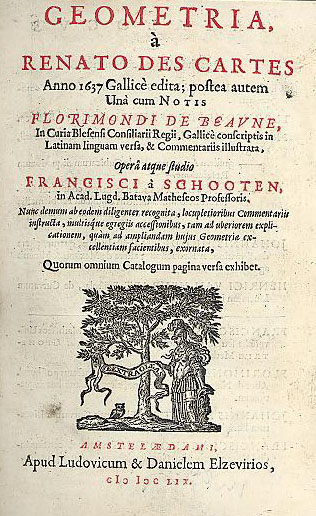History




Descartes lived 1596-1650. He is known for his contribution to philosophy, physics, and mathematics. His method for solving for roots of polynomials was published 1937 in his only published mathematical work, The Geometry, which was one of the appendices of his bigger pieces, Discours de la Methode. In The Geometry, Descartes showed how arithmetic, algebra, and geometry could be combined to solve problems. (Swetz, 1)
This intrigued me because for one, Descartes had methods for solving higher degree polynomials that were different from the modern-day methods I knew, and two, he used simple curves to do it.
Descartes lived in a day where there were no calculators or computer programs. His curves and lines were made with a protractor and straight edge. We will be looking at how he did it, but we will be using a computer program called Geogebra to draw our straight lines and curves. This program will be able to draw the straight lines and curves, just without all the hassle of using a protractor and straight edge.
Along my journey of studying Descartes' Method, something new occurred to me. It was something I felt I already knew, but I had never thought it in this perspective. And this was key to understanding how Descartes' Method worked. I will first show you a simple system of linear equations, something we should already be familiar with how to solve:
y=-5x+3
y=3x-2
We would solve for x by setting them equal, right? And then plugging it back in to one of the equations to solve for y. Or, another method, we could graph each of them and the solution would be the intersection. (Rubinstein, 1)
Now let us look at just one linear equation, y=5x+3. We want to know the x intercept. We can do this by simply plugging in 0 for y and algebraically solving for x, or we can plug in 0 for y and graph the two lines, y=5x and y=3. The x-coordinate of the intercept of these two lines will be equal to the x intercept. (Rubinstein, 1)
We can do the same with a quadratic. Say we were given the quadratic y=x^2-x-12 and we wanted to find the x intercept(s). We could solve this algebraically by plugging in 0 for y and using methods such as factoring or using the quadratic formula. We could also solve for the x intercept(s) graphically by graphing the functions, y=x^2 and y=x+12. The x intercept(s) are equal to the x coordinates of the intersection(s) of these two functions. (Rubinstein, 1)
I had never thought about solving for the x intercepts of polynomials this way. You could also use this method to solve for the x intercepts of higher order polynomials as well. (Rubinstein, 1) Since you can solve for the x intercepts of polynomials this way doesn't necessarily mean you should. Many polynomials' x intercepts are irrational. It would be hard to find exact solutions if you used this method.